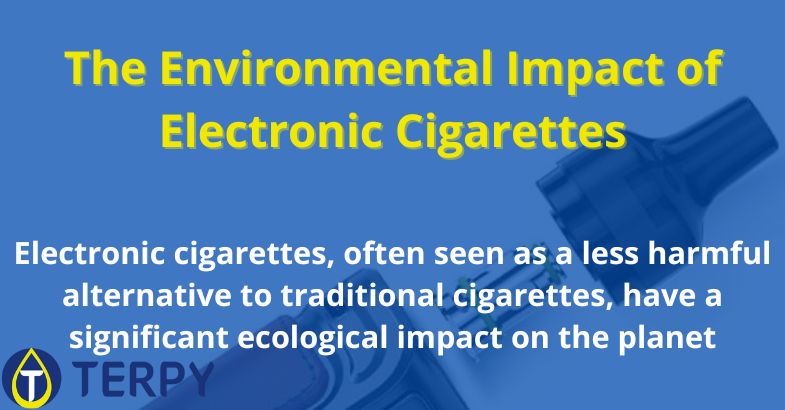Published on: 21/06/2024
Electronic cigarettes, often seen as a less harmful alternative to traditional cigarettes, have a significant ecological impact on the planet
In recent years, much attention has been given to the health effects of e-cigarettes, but it is also necessary to examine their environmental impact and sustainability.
In this article, we will explore how electronic cigarettes affect the environment by looking at their production, usage, and disposal.
Raw Materials and Manufacturing Processes of Electronic Cigarettes
The production of e cigarettes involves a variety of materials and industrial processes. The main components include:
- The battery
- The liquid tank
- The heating coil
- The outer casing
Each of these parts is made from different materials, each with its own environmental impact.
Batteries: typically, e-cigarettes use lithium-ion batteries, which require the extraction of lithium and other rare metals. This extraction process is notoriously harmful to the environment, causing deforestation, water pollution, and destruction of natural habitats. Additionally, battery manufacturing consumes a large amount of energy, further contributing to the carbon footprint of the final product.
Liquid Tank and Outer Casing: these are often made from plastic, a petroleum-derived material. The production of plastic not only consumes fossil resources but also generates greenhouse gas emissions and chemical waste. Moreover, plastic is a non-biodegradable material that can persist in the environment for hundreds of years, adding to the growing problem of plastic pollution.
Read also: Puff ban in France: here’s what’s happening


Daily Use and Environmental Impact
During everyday use, electronic cigarettes have a relatively lower environmental impact compared to traditional tobacco products. They do not produce smoke or ash, thereby reducing air pollution and the risk of fires. However, this does not mean they are entirely harmless to the environment.
E-liquids: the liquids used in electronic cigarettes, known as e liquids, typically contain propylene glycol, vegetable glycerin, nicotine, and flavorings. While many of these ingredients are not particularly harmful in small quantities, their release into the environment can still have negative effects. For example, propylene glycol and vegetable glycerin can contribute to fog formation and pollute water sources if disposed of improperly.
Cartridges and Tanks: rechargeable cartridges and tanks can become hazardous waste if not disposed of correctly. The plastic and residual e-liquid can leach into the soil and groundwater, potentially harming local wildlife and plants.
Disposal and Recycling Challenges
One of the major environmental issues associated with electronic cigarettes is their disposal. As electronic devices, e-cigarettes are considered electronic waste (e-waste), which poses significant challenges for global waste management.
Lithium-ion Batteries: if not disposed of properly, these batteries can pose a fire hazard and release toxic chemicals. Other electronic components, such as circuit boards, contain heavy metals and hazardous substances that can pollute the environment if not treated appropriately. The plastic from the outer casing, as mentioned earlier, is non-biodegradable and contributes to plastic pollution.
Recycling Complications: recycling e-cigarettes is complicated due to their multi-material composition. Separating the different components for recycling requires specialized processes that are not always available or cost-effective. As a result, many electronic cigarettes, in particular those like the vape pens, end up in landfills or, worse, are littered in the environment.
Comparison with Traditional Cigarettes: a Lesser Evil?
Compared to traditional cigarettes, electronic cigarettes might seem like a more environmentally friendly choice. Traditional cigarettes produce cigarette butts, which are one of the most common and polluting types of litter in the world. Cigarette filters, made of cellulose acetate, take years to degrade and release toxic chemicals into the environment.
Additionally, tobacco production is one of the most polluting agricultural practices, requiring intensive use of pesticides, fertilizers, and water. The combustion of tobacco also produces a wide range of harmful chemicals that pollute the air and pose health risks to both humans and animals.
Despite these negative aspects of traditional cigarettes, electronic cigarettes are not free from environmental criticism. While they may reduce some problems, they introduce new ones, particularly in terms of electronic waste and chemical disposal.
Solutions for More Sustainability
To address the environmental issues associated with electronic cigarettes, innovative solutions and collective efforts are needed. One promising approach is the development of regenerable electronic cigarettes, focusing on sustainability. Here are some strategies that could help reduce the ecological impact of electronic cigarettes:
Eco-friendly Design
Manufacturers can invest in research and development of more sustainable materials and designs. For example, using biodegradable or recyclable plastics, safer and more easily disposable batteries, and less polluting electronic circuits could make a significant difference.
Recycling Programs
Implementing effective and accessible recycling programs is crucial. Manufacturers and retailers can incentivize consumers to return used electronic cigarettes through discounts or other benefits. Collaborating with companies specializing in electronic waste recycling can significantly improve the management of these wastes.


Consumer Education
Informing consumers about the environmental risks of electronic cigarettes and how to dispose of them properly is essential. Awareness campaigns can help reduce irresponsible disposal of devices and promote more responsible recycling practices.
Regulations and Legislation
Governments can play a crucial role by implementing regulations that require manufacturers to adhere to higher environmental standards. For example, laws mandating the use of recyclable or biodegradable materials, or incentivizing recycling through taxes or subsidies, could have a significant impact.
Read also: How to refill disposable e-cigs and why you should avoid doing it
Conclusion
To sum up, in terms of environmental sustainability, electronic cigarettes represent a complex challenge. They offer advantages over traditional cigarettes but are not free from negative ecological impacts.
To create a more sustainable future for electronic cigarettes, a combination of technological innovation, effective policies, and individual responsibility is required. Only through collective effort can we hope to minimize the environmental impact of these devices and ensure they remain a safer choice not only for our health but also for our planet.
If you’re a vaping enthusiast, visit our online shop Terpy! We have incredible selections and a wide range of products waiting for you!





